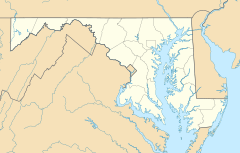Beverley Beach, Maryland facts for kids
Quick facts for kids
Beverley Beach, Maryland
|
|
|---|---|
| Country | |
| State | |
| County | |
| Time zone | UTC−5 (Eastern (EST)) |
| • Summer (DST) | UTC−4 (EDT) |
| GNIS feature ID | 583199 |
Beverley Beach is a lovely place in Anne Arundel County, Maryland, in the United States. It's not a city or town with its own government, but rather a community that's part of the larger county. Today, Beverley Beach is a fun county park where everyone can enjoy the beautiful beachfront.
In 2019, the state decided that the beach should be open to everyone. If you want to visit, you can only park at the main entrance of Beverly Triton Nature Park. This park is located at 1202 Triton Beach Road in Edgewater, Maryland. Parking inside the Beverley Beach community itself is not allowed.
Contents
Discovering Beverley Beach's Past
Beverley Beach has a really interesting history. It started out as a private resort and has changed a lot over the years. Let's explore how it became the county park we know today.
How Beverley Beach Began
A successful lawyer from Baltimore named Edgar Kalb opened Beverley Beach in 1925. He and his family also bought a nearby area called Ford Beach in 1942, which they renamed Triton Beach. The land was planned for over a hundred family homes. This plan was officially named Beverley Beach. We're not sure exactly where the name came from, but it might be a family name. The area is located near the community of Mayo, at the end of Highway 214.
The Exclusive Beach Resort
Kalb kept the best part of the bayfront property for a special day resort. This resort was also called Beverley Beach. He also built his own house there. The part of the shore with sandy ground was for resort members. The other part, with a muddy bottom, was where his house was. This area could also be used to make the resort bigger later on.
Fun and Games at the Resort
It's thought that Edgar Kalb helped bring slot machines to Anne Arundel County in 1943. This was a big boost for his resort! Kalb built three main buildings, called 'pavilions'. Two were connected, and one stood by itself. The standalone building had changing rooms and showers for people swimming in the Chesapeake Bay.
One of the other pavilions was filled with slot machines and other coin games. The pavilion furthest south had two snack stands. They sold fast food, drinks, and beer. There were also many tables and chairs for dining. At the very north end, there was a dance floor and a stage for bands. This was a very popular spot for young people on weekends and holidays.
In the late 1940s, the dance area became a bingo hall. The dining area was changed to hold even more slot machines. A swing set was also added outside for kids to play on.
Swimming in the Chesapeake Bay
The swimming area at Beverley Beach was about 300 feet long. It stretched from the northern edge of the property to south of Kalb's house. It went about 100 to 120 feet into the Chesapeake Bay. There were several square wooden platforms floating in the water. These were supported by air-filled barrels. One or two lifeguards would sit on these floats. They had small boats to help swimmers who got into trouble.
In late summer, the warm bay waters often had small stinging jellyfish called sea nettles. Kalb had a clever way to deal with these. He put up special nets around the swimming area. These nets were made of wire mesh with small openings. They were put up in May and taken down in September. Every evening, a lifeguard would hang lanterns on the poles holding the nets. This was to warn boats about the nets. In the mornings, the lanterns were taken down and refilled. Lifeguards also found soft-shelled crabs clinging to the nets, which they would collect.
A Popular Destination
On busy weekends, Beverley Beach attracted hundreds of cars. Many busloads of people came from the Washington and Baltimore areas. It was a very popular place for people to visit. The resort season ran from early June until Labor Day. Other times of the year were too cold for swimming or sunbathing.
Changes Over Time
In the 1940s and early 1950s, there were strict rules about who could go where in Maryland. Beverley Beach hired many people from the local community. However, they were only allowed in the resort if they were working. The resort tried to get around the rules by saying only "members" could enter. Memberships cost fifty cents.
In the 1950s, a court decided that this "membership" trick wasn't fair. The court ordered the resort to allow everyone to use it. Instead of following the court order, Edgar Kalb decided to close the resort in 1968.
In 1998, a newspaper called The Baltimore Sun reported on this. It said that Kalb had a sign that only allowed "white gentiles" in. Many people remembered him also turning away people from other backgrounds. The county, some said, didn't do much about Kalb's rules for a long time. Kalb himself said he would rather close the place than open it to everyone. And that's what he did.
Today, Beverley Beach is a public county park for everyone to enjoy.



